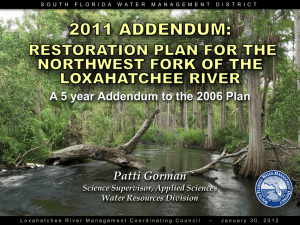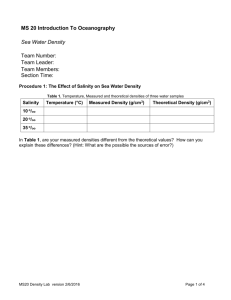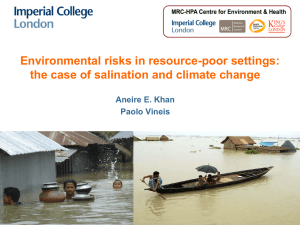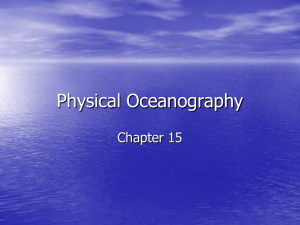Freshwater Flow Requirements and Management Goals
advertisement
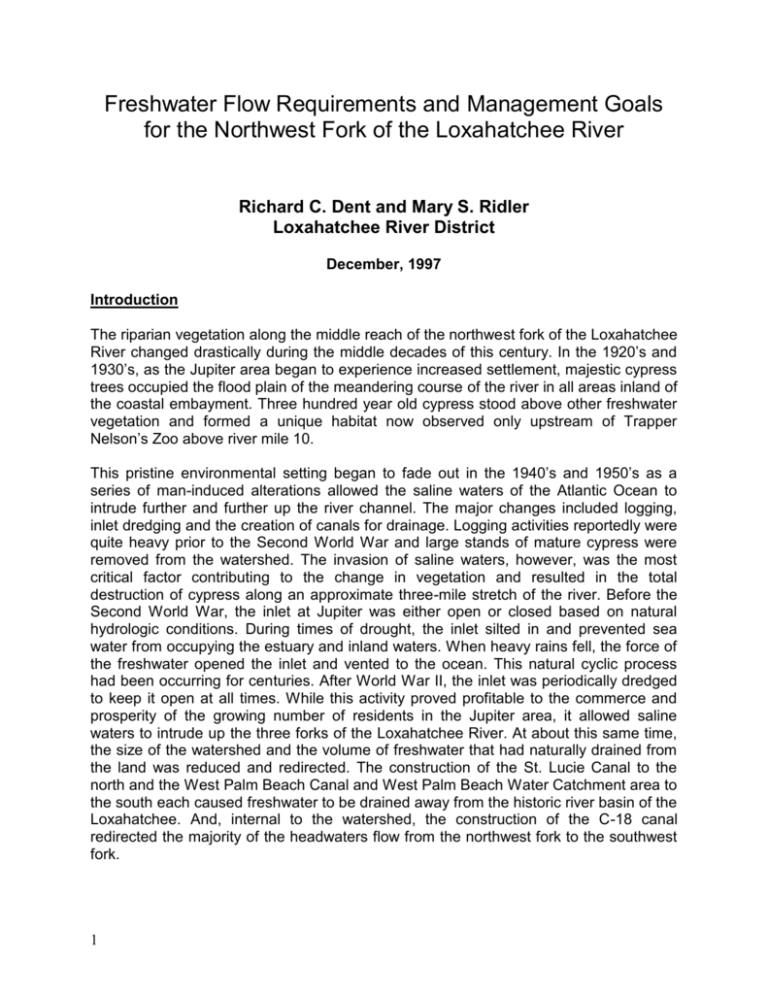
Freshwater Flow Requirements and Management Goals for the Northwest Fork of the Loxahatchee River Richard C. Dent and Mary S. Ridler Loxahatchee River District December, 1997 Introduction The riparian vegetation along the middle reach of the northwest fork of the Loxahatchee River changed drastically during the middle decades of this century. In the 1920’s and 1930’s, as the Jupiter area began to experience increased settlement, majestic cypress trees occupied the flood plain of the meandering course of the river in all areas inland of the coastal embayment. Three hundred year old cypress stood above other freshwater vegetation and formed a unique habitat now observed only upstream of Trapper Nelson’s Zoo above river mile 10. This pristine environmental setting began to fade out in the 1940’s and 1950’s as a series of man-induced alterations allowed the saline waters of the Atlantic Ocean to intrude further and further up the river channel. The major changes included logging, inlet dredging and the creation of canals for drainage. Logging activities reportedly were quite heavy prior to the Second World War and large stands of mature cypress were removed from the watershed. The invasion of saline waters, however, was the most critical factor contributing to the change in vegetation and resulted in the total destruction of cypress along an approximate three-mile stretch of the river. Before the Second World War, the inlet at Jupiter was either open or closed based on natural hydrologic conditions. During times of drought, the inlet silted in and prevented sea water from occupying the estuary and inland waters. When heavy rains fell, the force of the freshwater opened the inlet and vented to the ocean. This natural cyclic process had been occurring for centuries. After World War II, the inlet was periodically dredged to keep it open at all times. While this activity proved profitable to the commerce and prosperity of the growing number of residents in the Jupiter area, it allowed saline waters to intrude up the three forks of the Loxahatchee River. At about this same time, the size of the watershed and the volume of freshwater that had naturally drained from the land was reduced and redirected. The construction of the St. Lucie Canal to the north and the West Palm Beach Canal and West Palm Beach Water Catchment area to the south each caused freshwater to be drained away from the historic river basin of the Loxahatchee. And, internal to the watershed, the construction of the C-18 canal redirected the majority of the headwaters flow from the northwest fork to the southwest fork. 1 Within the span of only a decade or two, the giant cypress trees living along much of the northwest fork of the Loxahatchee River died because their root systems were now fed from groundwater contaminated with salt. As the entire riparian habitat changed, the native fauna, including otter, alligator and largemouth bass, all retreated upstream toward the headwaters and into Jonathan Dickinson State Park along the floodplain of Kitching Creek. By the late 1960’s and early 1970’s, only the dead snags of ancient cypress remained along 5,000 meters of a riverbank now dominated by flora and fauna characteristic of a brackish water ecosystem, including red mangrove, mullet and crabs. Water quality analyses conducted in the early 1970’s revealed that the water, once fresh, now exhibited salinity concentrations that typically ranged between two and ten parts per thousand. And, during times of drought, conditions quickly degraded and high salt concentrations were allowed to intrude far upstream, at times detected over fifteen miles from the inlet. Moving the salt water further downstream and re-establishing a consistent freshwater ecosystem within a portion of Jonathan Dickinson State Park has been high on the environmental agenda of the local community for nearly three decades. This report is the latest in a series of documents intended to move closer to the stated goal. It has been compiled to accomplish several purposes, the major of which are listed below: ● to briefly summarize the activities that addressed the salinity problem from 1970 to 1995 ● to review the methodology employed in gathering new information, ● to present the findings of a twelve month intensive study of salinity, ● to combine the new salinity data with flow information and establish relationships, and, to offer recommendations for new minimum flow goals for the successful management of freshwater conditions in the northwest fork of the Loxahatchee River. Prior Analytical Works, Goals and Activities From the early 1970’s through the mid 1980’s, a great deal of attention was given to the problem of salt water intrusion. Researchers identified the extent of the problem, presented reasons for the problem and began evaluating measures to retard the further migration of saline waters. A summary of the major efforts includes the pioneering work in the early 1970’s by the U.S. Geological Survey under Harry Rodis and the expansion on that work provided by Ben McPhearson and others a decade later. Dewey Worth and the South Florida Water Management District (S.F.W.M.D.) analyzed the saline environment in the estuary and northwest fork of the river in the middle 1980’s. And, the Jupiter Inlet District commissioned a series of works over a fifteen year span beginning in the mid 1970’s. As a scientific compendium, these reports described the process of saline intrusion and defined the conditions present, set goals for holding the encroaching salt water below Kitching Creek and recommended actions needed to achieve the goal. The first and 2 most significant technical recommendation was made by Rodis in 1971 and called for the provision of a minimum 50 cubic feet per second (cfs) flow in the vicinity of the S.R. 706 bridge and the Lainhart dam. The initial implementation of this recommendation was made possible by the installation of a culvert in the C-18 canal. This structure, known as G-92, allowed water from the Loxahatchee Slough and the C-18 canal to be directed to a conveyance canal, designated C-14, and into the uppermost reach of the Loxahatchee River. A three way operational accord was struck with the S.F.W.M.D. installing the structure, the South Indian River Water Control District allowing the use of the C-14 canal and the Loxahatchee River District providing the personnel to operate the structure. In the mid 1980’s, the S.F.W.M.D. took three important steps to enhance the ability to provide the minimum flow called for. The District improved its operating protocol by holding greater amounts of water in the C-18 basin, rebuilt the two dams in the freshwater reach of the northwest fork and replaced the G-92 structure with a larger culvert and provided automatic operational controls. The early technical research on the river is also believed to have been instrumental in the ‘wild and scenic river’ designation that the Loxahatchee earned in 1985. Along with the recognition came the establishment of the Loxahatchee River Management Coordinating Council and the formulation of a management plan. The original National Wild and Scenic River Management Plan endorsed the 50 cfs minimum flow requirement and encouraged further investigation to more accurately project future needs. By the middle of the present decade, three additional initiatives were being enacted as measures to retard the further migration of saline waters and begin ‘turning the tide’ to reclaim a portion of the lost habitat. The first of these initiatives was the closure of certain channels through the mangroves that had been created within the past twentyfive years and were acting to short cut the historic meandering flow pattern of the northwest fork. The Jupiter Inlet District constructed earthen and rock dams to seal off the short cuts and re-establish the longer flow routes for the river. Salinity studies conducted by the Loxahatchee River District demonstrated that the construction was successful in lowering the concentration of salt water above the closures. The Loxahatchee River District initiated the second action in 1994 after new salinity and flow relationships were recorded and analyzed. In a report before the Loxahatchee River Management Coordinating Council, the District presented the new data, compared it to U.S.G.S. data generated ten and twenty years earlier and suggested that the 50 cfs minimum flow requirement for the river should be modified. It was recommended that the new flow requirements incorporate a seasonal element and set new minimum needs in a range between 70 to 110 cfs. Further investigation was called for and the study described in the following sections of this report resulted. The final initiative undertaken in recent years was the purchase of the remnant portions of the historic Loxahatchee slough and the planning for its beneficial management. The 3 S.F.W.M.D. has teamed up with other governments to model the slough. One of the several primary objectives of the project is to deliver greater volumes of water to the upper reach of the northwest fork of the Loxahatchee River. Monitoring Sites and Sampling Protocol Figure #1 is a map showing the middle reach of the northwest fork of the Loxahatchee River and the three sampling stations monitored for salinity during the study period. Station #63 is located at a depth of about 3.0 meters between mid channel and the southern shore at approximately river mile 6.5 in the vicinity of the south boat ramp in Jonathan Dickinson State Park. The station had been occupied previously by the U.S. Geological Survey, the S.F.W.M.D. and the Loxahatchee River District for salinity studies. Additionally, the site is in close proximity to a long term water quality monitoring station sampled by the Loxahatchee River District and other agencies. Station #64 is located approximately 1.5 miles upstream of Station #63 and about 0.5 mile upstream of the canoe concession in Jonathan Dickinson State Park. The site is near the eastern shore on the outside of a river bend where the depth exceeds 4.0 meters. The final sampling site, Station #65 is located above the confluence of Kitching Creek with the Northwest fork or about 0.8 mile upstream of Station #64. The depth at this station is 3.5 meters and sampling was conducted near the northern shore where the deepest portion of the channel is located. The specific sampling point at each site was located approximately one meter above the channel bottom and each site was marked by permanent buoy. 4 The equipment used consisted of three Hydrolab Datasonde Model #3 monitoring probes. These devices are capable of providing readings for salinity, dissolved oxygen, depth and other parameters a number of times during the day. With the probes set for half hour sampling intervals, 48 salinity readings were recorded each day for each station. The data are stored in the unit until the unit is retrieved and the information downloaded. Under normal operating conditions, the probes were placed on station for a period from 15 to 30 days, then removed for a few days to a week to download the data and calibrate and service the equipment. The maximum and minimum salinity readings for each day were used for analysis. As relates to time, the probes were maintained on station, with periodic removal for data acquisition and servicing, from March of 1996 through February of 1997. Over the twelve-month period, salinity concentrations were recorded ever half hour for 294 days. Figure #2 is provided to exhibit the maximum daily salinities at each station over the study period of record. The U.S. Geological Survey, as part of its national program, developed the flow data used in this report. Site # 02277600, described as Loxahatchee River near Jupiter, is located at the State Road (SR) 706 bridge and supports a staff gauge that has been monitored for over three decades. The river flow, in cubic feet per second (cfs), is calculated from stage-flow relationships that are periodically adjusted. Figure #3 shows the river flow at this site during the twelve-month study period. Study Findings and Results Figure #2 shows the relationship of maximum daily bottom salinity concentrations for each of the three stations over time. From March, 1996 through February, 1997, salinity at the downstream Station #63 fluctuated from 1 part per thousand (ppt) to nearly 25 ppt. Following a similar pattern, Station #64 ranged from 1 ppt to 15 ppt, typically lagging the concentration at Station #63 by 6 ppt to 12 ppt. And, the concentrations of salinity at the upstream most station, #65 are 2 ppt to 7 ppt lower than those observed at Station #64 and peaked at approximately 15 ppt. It is important to note that the twelve-month study period was slightly wetter than normal and followed several years of high rainfall. Higher salinity concentrations and a more frequent occurrence of brackish water would be expected under normal or dry conditions. 5 Figure #2: Relationship of Maximum Daily Bottom Salinity Stations #63, #64 & #65 S ta. #65 25 S ta. #64 20 S ta. #63 15 10 5 0 14 28 11 25 9 2 3 6 20 4 1 8 1 15 2 9 1 2 26 10 24 7 21 5 19 2 16 30 13 27 Sta . #65 Mar Apr May Jun Jul Aug Sep Oct Nov Dec Jan Feb 1996 1997 Figure #3: River Flow @ SR706 Expressed as 5-Day Averages March 1996 thru February 1997 300 Flow in cfs 250 200 150 100 50 0 1 4 7 10 13 1 6 19 22 2 5 28 31 34 37 40 43 46 49 52 55 5 8 61 64 6 7 70 Time in 5-day periods 6 As a general overview, Figure #2 shows that lower salinity levels are seen in the summer months when higher rainfall increases river flow. Conversely, higher salinity concentrations are evident in the drier winter months. The figure also provides an insight into the three general conditions resultant from the varying rates of freshwater flow. During conditions of high flow, such as in June and July of 1996 when flows at Lainhart dam averaged greater than 200 cfs, salt water is essentially flushed from the full reach of the study area. Under intermediate flow conditions of between 100 cfs and 200 cfs, as exemplified in the August, September, October time frame, the upstream station remains fresh, station #63 stays brackish and the middle site, Station #64, fluctuates from predominantly fresh to moderately brackish on occasion. An approximate sixty day period in November and December of 1996 shows extensive saline intrusion at all stations, a condition that is resultant from flows of 50 cfs or below at the SR 706 gauging station. One important observation made during the study was the sensitivity with which the concentration of salinity reacts to change in flow. Figure #4 shows salinity concentrations at Station #65 over an eleven-day period in February of 1997 and makes a comparison to upstream river flow. As is evident, a drop in the upstream flow rate from approximately 150 cfs to below 60 cfs over five days results in the almost immediate movement of salt water into the area. As the flow increases again to near former levels, the saline waters are pushed downstream away from the site. This quick response of salinity in reaction to changes in upstream flow was common and observed throughout the entire period of record. Figure #4 : Short Term Response 180 5 160 4 .5 140 4 3 .5 120 3 100 2 .5 80 2 60 1 .5 40 1 20 0 .5 0 0 7 th 8 th 9 th 1 0 th 1 1 th 1 2 th 1 3 th 1 4 th 1 5 th 1 6 th 1 7 th time in days 7 salinity in ppt flow in cfs of Salinity to Changes in River Flow February, 1997 The major purpose of this study was to show the relationships between flow levels in the Loxahatchee River near SR 706 and the concentrations of salinity at Stations #63, #64 and #65. This objective was accomplished by mathematical comparisons of select portions of the data set and by the graphical presentation of the flow-salinity relationship. Of initial interest was a desire to learn if the 50 cfs minimum flow requirement remained valid. One simple means to make that determination was to look at days when flows were 50 cfs or less and compare them to the salinity concentrations at the established sampling stations. During the twelve month study, salinity data were recorded on 294 days. On 33 percent of those days, the river flow at SR 706 was equal to or less than 50 cfs. A comparison of those days with salinity at Station #65 and Station #64 revealed the following. When the flow was equal to or less than 50 cfs, the salinity is greater than 2 ppt at Station #65 95 percent of the time and the salinity is greater than 2 ppt at Station #64 100 percent of the time. Clearly, flows below and equal to the 50 cfs recommended minimum are insufficient to maintain fresh water conditions at either of the two sampling stations. A brief look at the impact of an arbitrary new flow condition of 100 cfs reveals that, during the 41 percent of the sampling days with flows of 100 cfs or higher, salinity at Station #65 was never greater than 2 ppt and the salinity at Station #64 was greater than 2 ppt 9 percent of the time. A more complete picture of the relationships between flow levels and salinity concentrations is presented in Figure #5, Figure #6 and Figure #7. Figure # 5 Lainhart Flow vs. Max Salinity at Stations # 63 (Feb 96 -April 97) 30 Max Sal 63 25 Salinity in ppt 20 15 10 5 0 10 35 60 85 110 135 Lainhart Flow in cfs 8 160 185 210 235 Figure #6: Lainhart Flow vs. Maximum Salinity at Station #64 (Feb 96 - April 97) 25 Max. Sal 64 Salinity in ppt 20 15 10 5 0 20 45 70 95 120 145 170 195 220 245 Lainhart Flow in cfs Figure # 7 Lainhart Flow vs. Maximum Salinity at Station # 65 (Feb 1996 - April 1997) 16 14 Salinity in ppt 12 10 8 6 4 2 0 0 25 50 75 100 125 150 Lainhart Flow in cfs 9 175 200 225 250 Recommendations Prior to the completion of this document, the South Florida Water Management District requested access to the flow and salinity data generated under the study. A comparison of the salinity data to new flow data generated by the Water Management District was proposed. The reason was that the stage-flow rating tables used by the U.S.G.S. and by the South Florida Water Management District showed some degree of variance and a refinement of the data was recommended. In addition, the Water Management District volunteered to subject the data to sophisticated statistical analysis, the software for which was not available to the Loxahatchee River District. Final recommendations for new flow requirements and other management goals will await the completion of the Water Management District work; however, Figure #8 suggests interim recommendations for new management goals based on the U.S.G.S. flow data and the salinity information provided by this study. Figure #8: Recommended Minimum Flows and Suggested Flow Range for Management of the Freshwater Ecosystem 350 M in 300 300 300 300 300 300 M ax 250 200 200 200 200 F lo w in c f s 150 100 95 150 150 95 95 150 75 150 75 130 130 130 130 130 95 95 50 T im e in m o n t h s 10 c e D N o v t c O S e p g A u l u J J u n y a M A p r r a M e F J a n b 0
